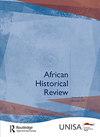Reconfigured Agrarian Relations in Zimbabwe, by Toendepi Shonhe
IF 0.1
Q3 HISTORY
引用次数: 0
Abstract
Zimbabwe’s Fast-Track-Land Reform Programme (FTLRP) at the turn of the century has generated much scholarship and heated debate in both academic and policy circles. Two major schools of thought have emerged: first is a group which has portrayed the FTLRP as a disaster of unmitigated proportions; the second strand is dominated by scholars like Ian Scoones, Sam Moyo and others, who have sought to identify its “positive outcomes without endorsing violence and abuses that accompanied the seizure of farms” (p. 150). It is partly to the latter school that Toendepi Shonhe makes a contribution. Through his case study of the Hwedza district in Zimbabwe’s Mashonaland East Province, Shonhe adds his voice to works that have sought to evaluate policy outcomes of the FTLRP. The book—a qualitative evaluation of the impact of the FTLRP—examines policy outcomes of land reform, including shedding light on the reinsertion of capital into Zimbabwe’s agrarian productivity, accumulation and class formation processes after the FTLRP.《津巴布韦重新配置的农业关系》,作者:Toendepi Shonhe
津巴布韦在世纪之交的快速土地改革计划(FTLRP)产生了许多学术成果,并在学术界和政策界引发了激烈的辩论。出现了两个主要的思想流派:第一个派别把过渡时期和解方案描绘成一场无法减轻的灾难;第二种观点主要由Ian Scoones、Sam Moyo等学者主导,他们试图确定其“积极的结果,而不赞同与没收农场相关的暴力和虐待”(第150页)。Toendepi Shonhe在一定程度上为后者做出了贡献。通过对津巴布韦东马绍纳兰省Hwedza地区的案例研究,Shonhe为那些试图评估FTLRP政策成果的工作增添了自己的声音。这本书是对土地改革政策影响的定性评估,考察了土地改革的政策结果,包括揭示了在土地改革政策实施后,资本重新注入津巴布韦的农业生产力、积累和阶级形成过程。
本文章由计算机程序翻译,如有差异,请以英文原文为准。
求助全文
约1分钟内获得全文
求助全文

 求助内容:
求助内容: 应助结果提醒方式:
应助结果提醒方式:


